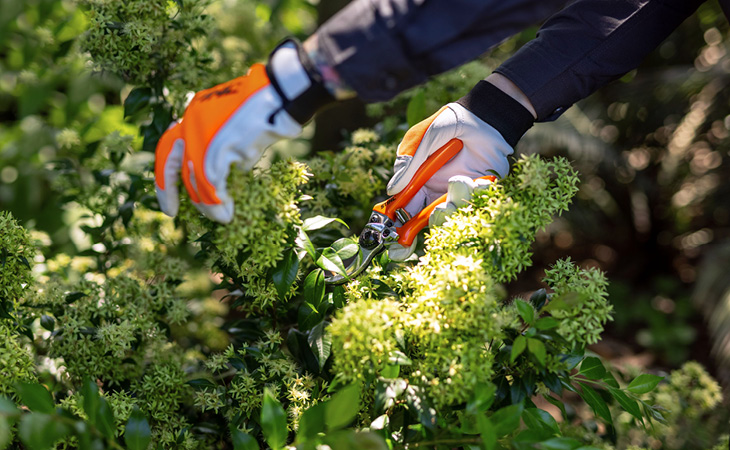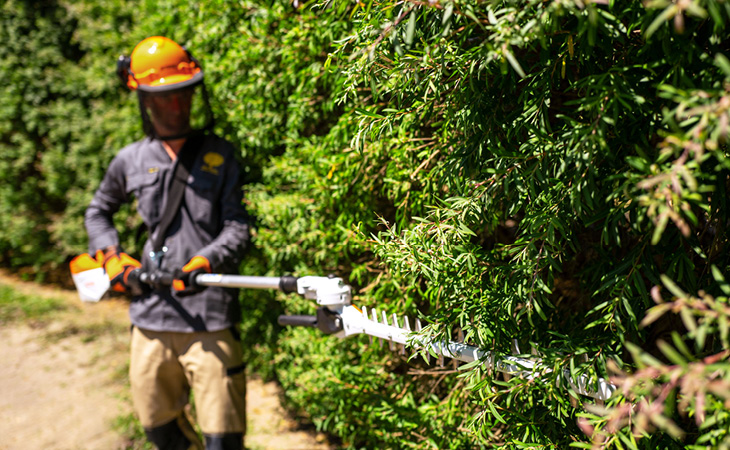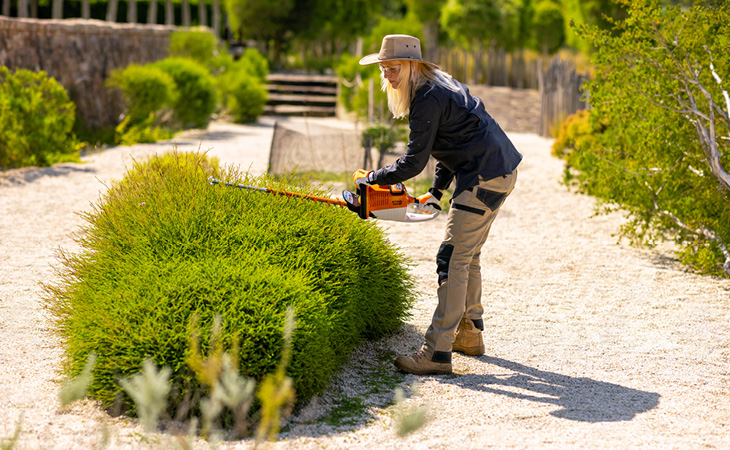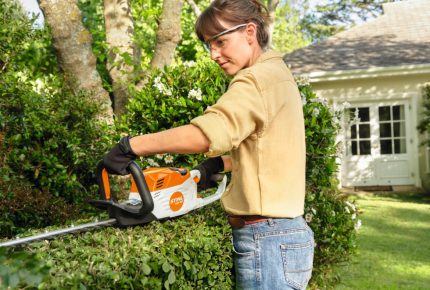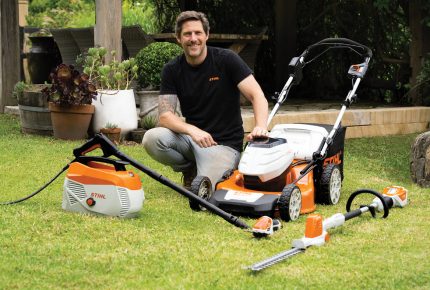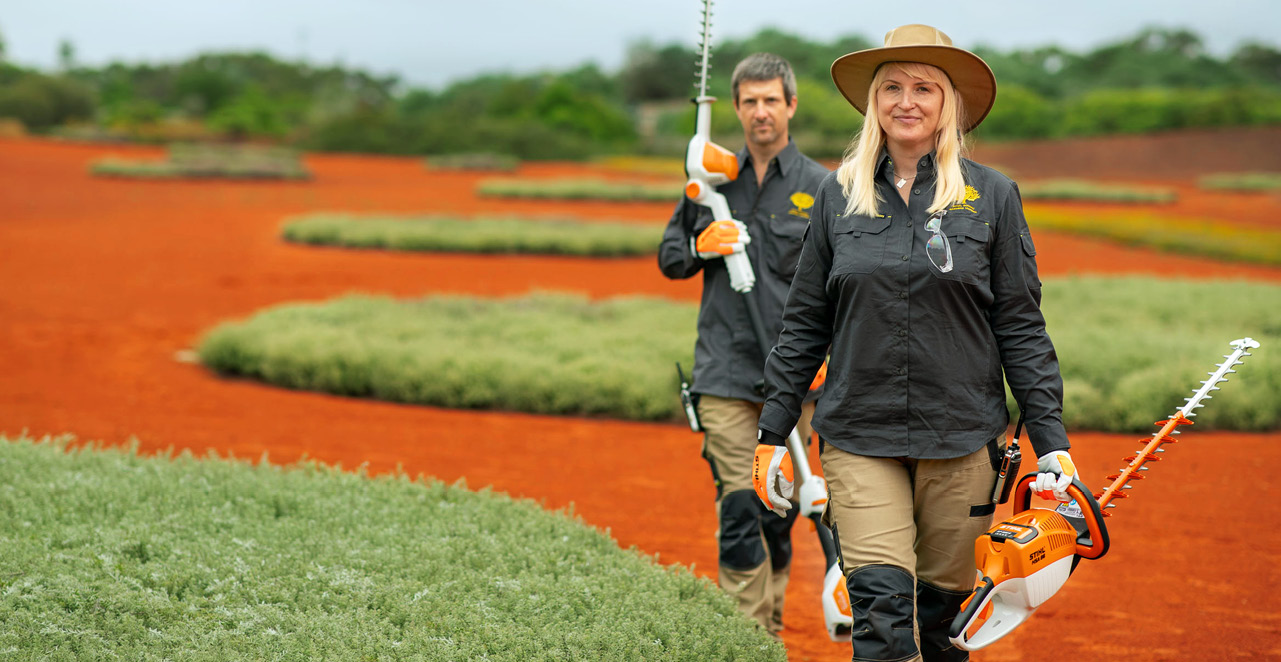
#Inspiration
Autumn Reboot: Hedge Trimming with Royal Botanic Gardens Cranbourne
STIHL’s resident garden expert Charlie Albone has trimmed many hedges in his time as a professional landscaper – both in Australia and the UK. It’s why he was especially interested to visit the magnificent Royal Botanic Gardens Cranbourne in Victoria, where he spoke to Horticulture Manager John Arnott about their ‘Autumn reboot’ process.
Autumn is an important time for the internationally acclaimed Gardens, which possess a stunning collection of Australian native flora and fauna. The team also care for over 1,400 endangered, rare and threatened species. In Autumn, the conditions are optimal for trimming these plants and others in the collection.
‘When you prune, what you’re effectively doing is stimulating new growth,’ John tells Charlie. ‘If you were to clip in Summer when the soil is dry (or Winter when the plants are less active) it can put the plant under stress. Autumn is an ideal time to prune because it’s gentle on the plants – days are cooler with available soil moisture. And there’s still sap flow so you’ll get a regrowth response.
Styles of hedge trimming
There are two distinct styles of hedge trimming: manicured, which delivers a formal appeal and naturalistic, which provides a more relaxed look and feel. Standing in the lush Gondwana Garden amidst mid-morning birdcalls, John takes Charlie through the Garden’s hedge trimming approach.
Manicured hedge trimming
‘When you’re using hedging in a design, it’s all about the effect that you’re after. You can have a naturalistic look or a more formal look… The leptospermum hedge here has a level of formality. It’s clipped pretty tightly and straight – this gives it a manicured feel. We do the same with our tea tree hedge.’
Naturalistic hedge trimming
‘For our naturalistic look, such as this sub-alpine podocarpus. We could clip it formally but in this garden, which is telling the story of the Gondwana, it’s a rainforest garden. So we want a natural look and feel, which we achieve with hand tools like secateurs.’
So what’s the trick with naturalistic pruning? ‘You walk away after pruning it and it doesn’t look like it’s been pruned,’ John chuckles.
How to choose a hedge plant
Choose the right form
When it comes to choosing the right plant for hedges, it’s important to have foliage density.
‘There are a bunch of things that won’t tolerate clipping into a hedge form, just because they’re too rangy or too open,’ says John. ‘Whereas things with little leaves and dense habits tend to lend themselves more to that formal clipping.’
Charlie points out that smaller leaves are better because you don’t see the leaf cuts, and John agrees. ‘It’s surprising what you can hedge but you do need foliage density.’
Embrace Australian natives
There are a diverse range of Australian plants that are amenable to hedging, including leptospermum, which the Gardens also favour.
John adds: ‘There’s a whole suite of callistemons… and this podocarpus would clip like a box hedge.’ Charlie also points out that westringia fruticosa would also clip nicely.
Others include acmena (or lilly pilly), melaleuca linariifolia and the flowering leionema ‘green screen’.
How to trim hedges
Allow for enough sunlight
Charlie suggests letting your hedges’ bases grow out a little more than the top. This creates a slight angle, allowing your hedge to get more sunlight over it. ‘But it depends on the orientation in the garden and how the sun travels over that hedge. If it’s north facing, you might decide to keep the edge flat.’
Prune from a young age
When it comes to caring for Australian native plants, there’s a myth that they don’t require fertiliser, water or pruning. According to John, none of that is really true.
‘They’ll survive, but they’re much better when cared for. Inland natives especially, if left alone, will get very long and leggy – they lose that ornamental appeal. By regularly pruning from a young age, you can promote a dense bushy habit. You don’t want to wait until it’s your desired height. You want to be pruning it incrementally from the beginning.’
Know when to trim hedges (and when not to)
For flowering hedges, it’s important to prune after flowering. Especially plants that flower on first year wood. ‘You get a flush of growth and that’s where all the buds are. If you continually prune those plants, you could be pruning off flowering potential. So pruning after flowering is sensible.’
John recommends taking off a third when pruning most plants, for example grevilleas. ‘You could go a little harder if you didn’t prune the plant when it was smaller.’
Tools of the trade
The Gardens use a range of professional STIHL tools including the HSA 86 battery hedge trimmer. It’s part of the AP System, a powerful range of 30+ tools all powered by the one battery. For taller plants, the Gardens’ horticulturists will opt for a long-reach battery tool, like the HLA 135 K.
‘As a rule of thumb, if it doesn’t feel safe – it isn’t,’ says John. ‘Go for something bigger. If you can do it from terra firma, that’s going to be much safer.’
Garden shears, secateurs and pruners like the STIHL GTA 26 are also favoured, with STIHL Superclean resin solvent the preferred product for blade cleaning.
To receive more professional Autumn gardening tips from Charlie Albone’s visit to Royal Botanic Gardens Cranbourne, subscribe to the STIHL newsletter here.

